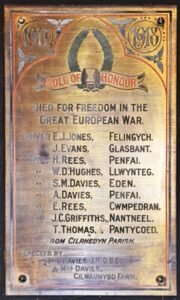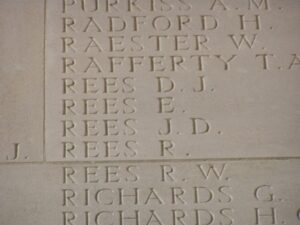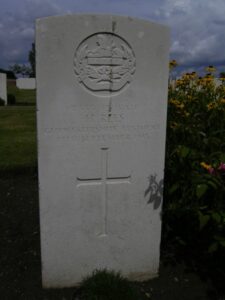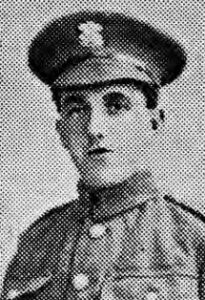Capel Iwan is a small village situated about three miles south of Newcastle Emlyn, adjoining the parishes of Cenarth and Cilrhedyn. The men of the area who fell during the Great War are commemorated on a brass plaque, which is located inside Capel Ifan Chapel and was unveiled by John Hinds, MP on Friday 1 August 1919. There are two plaques inside the Chapel in memory of two men who fell during World War Two, and a third memorial in the village which commemorates two Royal Air Force men who were killed in an aircraft crash at Gors Farm. The photographs of the memorials are courtesy of Raymond Jones.
The Great War, 1914-1918

Arthur Davies, Private, 52, Australian Infantry. Arthur was born in 1884, the son of John and Mary Ann Davies, of Penfai, Capel Iwan. He had emigrated to Australia at the age of 24, and worked at Broome, Western Australia as a pearler. He attested at Broome on 5 February 1915 into the 28th Battalion, Australian Infantry. The battalion left Australia on 29 June 1915 aboard the HMAT Ascanius, and moved to Egypt, where it trained for two months prior to landing at Gallipoli on 10 September, as part of the 7th Brigade, 2nd Australian Division. The heavy fighting there was over by then, and the battalion left Gallipoli for Egypt two months later. The 2nd Division moved to France on 16 March 1916, and saw its first major action at Pozières between 28 July and 6 August 1916. Arthur was wounded at Pozieres on 29 July, and was evacuated to the 1/2nd Midland Field Ambulance at Warloy-Baillon, where he died of his wounds later that day. He was 33 years old, and is buried in Warloy-Baillon Communal Cemetery Extension, France.

Samuel Mathias Davies, Private, 37569, Welsh Regiment. Samuel was born in Newcastle Emlyn, the son of Benjamin and Jane Davies. The family had moved to Llangennech prior to the war, and Samuel enlisted at Pontardulais into the 8th Battalion, Welsh Regiment, which was attached to 40 Brigade, 13th (Western) Division. On 13 June 1915 the Division sailed to Alexandria. Between 6 and 16 July 1915 the Division landed on Cape Helles and relieved the 29th Division. They left and returned to Mudros at the end of the month, and the entire Division landed at ANZAC Cove between 3 and 5 August 1915, taking part in the Battles of Sari Bair, Russell’s Top, and Hill 60, ANZAC. Soon afterwards the Division was transferred from ANZAC to Suvla Bay, and it was evacuated from Suvla on 19 December 1915, when it moved to the Helles bridgehead, where they faced the last Turkish attacks at Helles. On 8 January 1916, the Division was evacuated from Helles, and by 31 January was concentrated at Port Said, where they held forward posts in the Suez Canal defences. On 12 February, 1916 the Division began to move to Mesopotamia, to strengthen the force being assembled for the relief of the besieged garrison at Kut al Amara. By 27 March, the Division had assembled near Sheikh Saad and came under orders of the Tigris Corps, and then took part in the attempts to relieve Kut. Samuel sadly died of sickness in Mesopotamia on 21 April 1916, aged 20, and is buried at Amara War Cemetery. Samuel is also commemorated at Pontardulais.

James Evans, Driver, W/2795, Royal Field Artillery. James was the son of Joshua and Hannah Evans, of Glaspant, Cilrhedyn. He had worked as a miner at Llangeinor prior to the war, and in 1910 returned home to marry the widowed Elizabeth Waddup (nee Rees), of the Fox and Hounds, Cwmcych. The couple then lived at 7, Brynhyfryd, Pontycymmer. James enlisted at Bridgend into the Royal Field Artillery. He served with their ‘A’ Battery, 119th Brigade, which was attached to the 38th (Welsh) Division. The Division had landed in France during December 1915 and had spent their first winter in the trenches near Armentieres. In June they marched south to the Somme, where they were tasked with the capture of Mametz Wood. The attack on the wood began on 7 July, but met with fierce resistance, and it took four days to clear the wood. The Division suffered terrible casualties at Mametz, and were taken out of the line, and moved to Ypres to rebuild. Here they fought at Pilckem and Langemarck, then moved to Armentieres, where they remained from September 1917 until March, 1918 when the German Spring Offensive was launched. In April the Division were moved to the Somme, but James was killed in action prior to the move, on 17 April 1918. He was 46 years old, and is buried at Le Grand Hasard Military Cemetery, Morbecque. He is also commemorated at Newcastle Emlyn. Elizabeth returned to West Wales, to live at 7, Penlan Terrace, Newcastle Emlyn.

Joshua Cromwell Griffiths, Private, 440205, Labour Corps. Joshua was born in Penbryn in 1893, the son of James and Margaret Griffiths. The family later resided at Nant Neel Farm, Clydey. Very little is known of Joshua, but he initially served with the South Wales Borderers, with the service number 31232, before being downgraded medically, and posted to the Labour Corps. Joshua died at home of sickness on 25 March 1918, aged 25, and is buried at Capel Ifan Congregational Chapelyard.

William David Hughes, Private, 2231, Welsh Regiment. William was the son of David Rice Hughes and Ann Hughes, of Llwynteg, Cwm Morgan. He enlisted at Carmarthen into the 1/4th Battalion, Welsh Regiment. The Battalion formed part of 159 Brigade, 53rd (Welsh) Division, and moved to the Mediterranean, sailing from Devonport in July, arriving at Mudros by 5 August 1915, and landing at Gallipoli on 8 August 1915. Here they immediately faced the chaotic leadership that was to lead to the ultimate failure of the campaign, and spent the next few days in isolated pockets, fighting against a Turkish counter-attack. The Division remained here throughout the coming months, and suffered severe losses in manpower strength during the great November 1915 blizzard on Gallipoli, when its total strength was reduced to less than that of a full-strength Brigade. On 11 December 1915 the Division was evacuated to Mudros, and by 23 December 1915 were moved to Egypt. They remained on the Suez Canal Defences for the next twelve months, which is where William was taken ill. He was moved to the Base Hospital in Cairo, where he died of sickness on 7 August 1916. William was just 20 years old, and is buried at Cairo War Memorial Cemetery.

Evan John Jones, Driver, 19801, Royal Field Artillery. Evan was born at Felingych in 1884, the son of John and Margaret Jones. His parents later resided in Cwmbwch, Rhydlewis. He enlisted at Newport, Monmouth into the Royal Field Artillery, and was posted to France on 2 September 1915, joining C Battery, 75th Brigade, Royal Field Artillery, which was attached to the Guards Division. Evan wasn’t to experience much of the war. He died on 20 September 1915, aged 25, and is buried in Bethune Town Cemetery, France. He is also commemorated at Troedyraur.

Evan Rees, Private, 73644, Royal Welsh Fusiliers. Evan was the son of David and Sarah Rees, of Giblin Cenarth, Ponteuney. He enlisted at Carmarthen into the 9th Battalion, Royal Welsh Fusiliers, who were attached to the 58th Brigade, 19th (Western) Division. The Division crossed to France between the 11th and the 21st July 1915, and moved to positions near Loos. The Division fought during the opening attack of the Battle of Loos, and then moved to the Somme, where they took part in the second wave of the attack on Ovillers-La Boiselle on the 1st July, capturing the village at heavy cost, and fought through the Somme Battles of Pozieres and the Ancre in 1916. They then moved North to Ypres, taking part in the Battle of Messines, and fought on the Menin Road and at Polygon Wood, before moving up to Broodseinde, Poelcapelle and Passchendaele Village itself, before moving to the Somme area to rest and rebuild. Evan was killed in action on the Somme on 4 January 1918, aged 23. He has no known grave, and so is commemorated on the Thiepval Memorial. He is also commemorated at Crymych.


Harry Rees, Private, 12335, Gloucestershire Regiment. Harry was born in Cenarth in 1891, and was brought up by his Grandmother, Mary Rees, at Penfai-Uchaf. He enlisted at Pentre into the 2nd Battalion, Gloucestershire Regiment. The Battalion was attached to 81 Brigade, 27th Division, which was formed in England in October-November 1914, from regular units returning from India, Hong Kong and Canada. On 21 December 1914 it landed in France and proceeded to the Western Front, where it fought at the Action of St Eloi, and at The Second Battle of Ypres. Harry was killed in action while the Division were stationed in Flanders, on 13 September 1915, aged 23. He is buried at Rue-Petillon Military Cemetery, Fleurbaix.

Thomas Thomas, Private, 125589, Machine Gun Corps. Thomas was the son of John and Ann Thomas, of Pantycoed, Cilrhedyn. He enlisted at Carmarthen into the army. He was posted to France, joining the 36th Battalion, Machine Gun Corps, which was attached to the 36th (Ulster) Division. The division had seen heavy fighting on the Somme in 1916, and at Ypres in 1917. It then fought at Cambrai later that year, before wintering in the Somme sector. When the Germans launched their offensive on the Somme on 21 March 1918 the division was again caught up in heavy fighting, and was moved to Ypres to rest. It saw further heavy fighting when the Germans switched their attack to the Lys Valley the following month. Thomas was mortally wounded here, and died on 29 May 1918, aged 24. He is buried at Solferino Farm Cemetery, Belgium. He is also commemorated at Drefach Velindre.


World War Two, 1939-1945

David Gwyn Davies, Radio Officer, Merchant Navy. David was the son of Richard Idwal and Winifred Elizabeth Davies, of 16, Tressilian Crescent, Brockley, Kent, and the husband of Ethel Davies, of 95, Pitfold Road, Lee, London. He was a Bank Clerk in London prior to the war, before becoming a Radio Officer with the Merchant Navy, and served aboard the S.S. Hillfern, a Newcastle-on-Tyne registered coastal steamer. On 31 October 1940 Hillfern sank about eight miles off Kinnaird Head, with the loss of eight of her crew. There are conflicting reports of her loss, either by striking a mine, or being attacked by German aircraft. David was among the men lost. He was 27 years old, and is commemorated on the Tower Hill Memorial, London. There is a plaque dedicated to David and his parents inside Capel Iwan Chapel, which his grandfather, Dr. Benjamin Davies, had been the Minister for many years.

Gwilym Rees Jones, Gunner, 1817827, Royal Artillery. Gwilym was the son of James and Rachel Jones, of Penfai, Capel Iwan. He served with 80 Heavy Anti Aircraft Regiment, Royal Artillery. The regiment served in North Africa with the 8th Army. Gwilym was killed during the advance on Tripoli, on 7 January 1943. He was 37 years old, and is commemorated on the Medjez-El-Bab Memorial, Tunisia. Gwilym does not appear to be commemorated locally.
John Vincent Lloyd, Fusilier, 4196126, Royal Welch Fusiliers. John was the son of John and Hannah Lloyd, of Clwb, Capel Iwan, and served in the 2nd Battalion, Royal Welsh Fusiliers. The Battalion left the UK in February, 1942 and sailed for Madagascar to capture the Naval Base of Diego Suarez, which was a French Naval Base that had been taken over by the Japanese, and garrisoned by Vichy French troops. John was killed during the ensuing fighting, on 6 May 1942, aged 23, and is buried at Diego Suarez War Cemetery, Madagascar. He is also commemorated at Crymych.

World War Two Vickers Warwick HG342 Memorial

The Vickers Warwick was designed as a two-engined heavy bomber, alongside the smaller Vickers Wellington. Various engines were used throughout its operational life, and by April 1940 the RAF began to use the Bristol Centaurus engine. On 14 October 1944, Vickers Warwick Mark III, Serial HG342, was flying from RAF Aberporth on a Centaurus XII engine test flight, when it crashed at Gors Farm, Capel Iwan, killing the Pilot and Flight Mechanic. These men are commemorated on a memorial which was unveiled on 14 July 2012 at Capel Iwan village green, after work by Cenarth Community Council. The two men are commemorated below.
Leonard Aubrey Crozier, Flight Lieutenant (Pilot), 141472, Royal Air Force Volunteer Reserve. Leonard was born in London in 1918, the son of Leonard John Alfred Crozier and Willa Blanche Crozier (nee Gerber), of South Benfleet. He enlisted into the Royal Air Force Volunteer Reserve soon after the outbreak of war and trained as a fighter pilot. Leonard had been shot down in France while flying a Hurricane with 85 Squadron in May 1940, but had escaped and returned to England. He married Margaret Benita Noakes at Blackpool later that year. By 1944, Leonard was based at RAF Filton with the Centaurus Flight. He was 26 years old when he was killed in the crash of his Warwick at Gors Farm, Capel Iwan on 14 October 1944, and was brought home for burial in South Benfleet (St. Mary) Churchyard, England. The photograph is courtesy of John Crozier.

Ronald Frederick McAllen, Leading Aircraftman, 1479575, Royal Air Force Volunteer Reserve. Ronald was born in 1922, the son of Charles Frederick Frank McAllen and Mabel McAllen (nee Russell), of 12, Westmeath Avenue, Leicester. He enlisted into the Royal Air Force Volunteer Reserve and trained as an engine mechanic with the Royal Air Force, before being posted to Transport Command at RAF Filton, near Bristol. Ronald married Marguerite Maycock at Leicester in 1943. He was 22 years old when he was killed in the crash of his Warwick at Gors Farm, Capel Iwan on 14 October 1944, and was brought home for burial in Humberstone (St. Mary) Churchyard, England.
